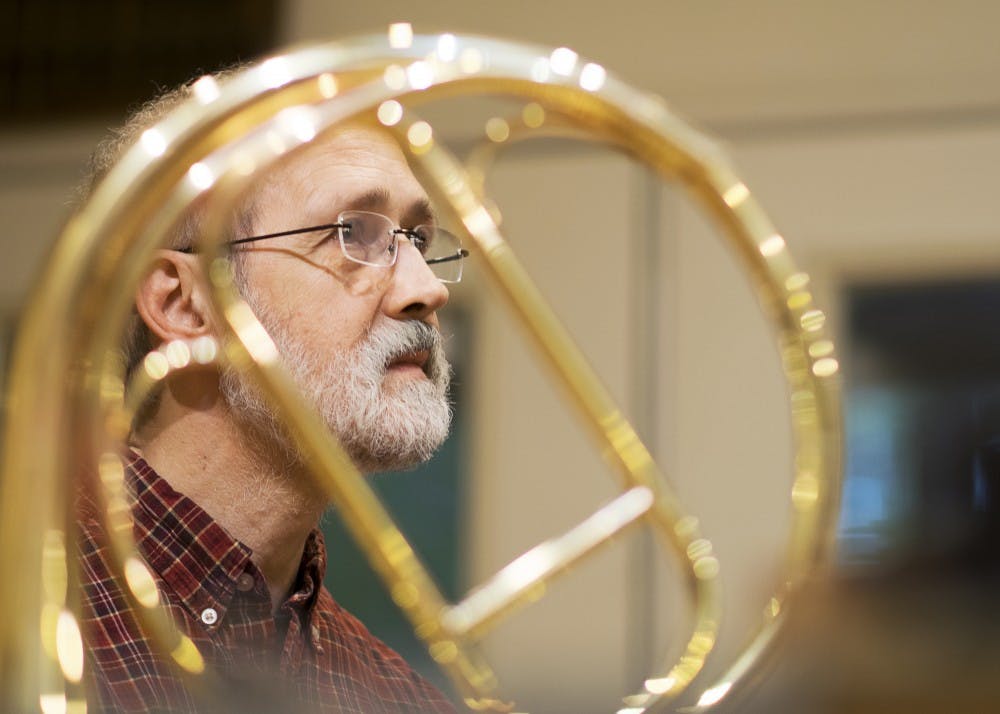Six miles off campus, down a gravel road and into the forested hills, Richard Seraphinoff, a Jacobs School of Music professor, makes natural horns in his workshop next to his house. He has been making natural horns since the 1980s. Now, a client has to wait up to a year and half for one of his natural horns.
Seraphinoff will be featured on PBS’s “A Craftsman's Legacy” for his work building high-quality natural horns. The episode entitled "The Brass Horn Makers" will air at 2:30 p.m. Saturday on WTIU.
He is the only maker of natural horns in the northern United States, and one of the few in the world, Seraphinoff said.
“If I did nothing else, I would make one horn every two weeks,” Seraphinoff said. “Each horn takes maybe a hundred hours. This year, I think I will make 15.”
Seraphinoff said when he was an undergraduate in the 1970s, the idea of playing on older period instruments was a new idea. There was an orchestra in Ann Arbor, Michigan, that played baroque music on period instruments, he said.
Seraphinoff said his teacher at the time was asked to play with them and asked Seraphinoff to come along and play with him. Seraphinoff needed a period instrument to play, and at the time there were only a couple of ways to obtain a natural horn.
“You could buy an antique horn, but they were really expensive,” Seraphinoff said. “There were a few people making copies of horns back then, but they hadn’t quite gotten to the point of making really exact precise copies. And then there was the possibility of taking a modern horn and removing the valves from it, which is what we did.”
A modern French horn can play all the notes on the chromatic scale, whereas the natural horn is one length of tubing that plays the overtone series of notes, Seraphinoff said.
The modern French horn is also bigger and louder to compensate for the larger orchestra size. A period orchestra had 15 to 20 musicians, whereas a modern orchestra has 60 to 80 musicians, Seraphinoff said.
Seraphinoff said he wanted better instruments, so he learned about the metalwork. Little by little, he said he put together the techniques of metalwork and the designs of the instrument. To do so, he went to museums and did drawings of period horns. He did a lot of measuring and working with the people who made tool, he said.
Seraphinoff has an apprentice that helps around the shop. Senior Barbara Bright-Read said she goes to Seraphinoff’s shop two or three times a week for a few hours to learn and help. She has been his apprentice for two years.
“He is incredibly smart, funny and compassionate,” Bright-Read said. “He and his wife are the two most lovely people I know.”
Bright-Read said that while she helps in the shop, they normally listen to music or NPR.
Bright-Read met Seraphinoff at a pre-college weekend and requested to be in his studio as a French horn performance major.
“I want to be a museum restorationist and custom instrument major,” Bright-Read said.
Seraphinoff said working with PBS was an amazing experience. The crew came early on a Saturday morning and a Sunday morning and left both nights, he said.
“The host of the show got his hands in the work and helped me do some things,” Seraphinoff said.
He said he was amazed how the 20 hours they spent filming would be turned into a half-hour show.
Seraphinoff said he grew up in Detroit, Michigan. He started his music career playing trumpet, but after having his braces removed, he found French horn to be better situated to him.
“I thought, 'Whoa, this is where it’s at,'” Seraphinoff said. “Then I discovered that the French horn has a lot of really good music.”
Seraphinoff decided to pursue a career in music during his senior year of high school.
“I started to think, 'Wow, maybe I could do this for a living, and maybe I should give it a try,'” he said.
He started as a music education major at Wayne State University in Detroit before deciding to pursue music performance during his sophomore year of college.
“I came from a family who made things,” Seraphinoff said. “My father, in our garage in the suburbs of Detroit, built airplanes. So I learned about tools and materials and how to use them and how to use them to make things.”




